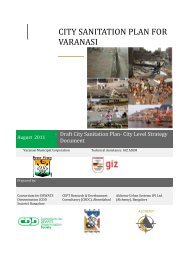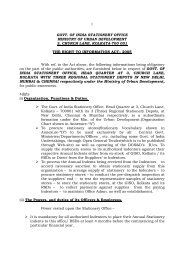CITY SANITATION PLAN - Ministry of Urban Development
CITY SANITATION PLAN - Ministry of Urban Development
CITY SANITATION PLAN - Ministry of Urban Development
Create successful ePaper yourself
Turn your PDF publications into a flip-book with our unique Google optimized e-Paper software.
Under these circumstances not only the construction but devising measures for strengthening<br />
operational and maintenance aspect <strong>of</strong> the community toilets becomes all the more important. This<br />
scenario necessitates initiatives not only in the construction but over and above in the ‘Operation &<br />
Maintenance’ (O& M) <strong>of</strong> community toilets.<br />
Involving user groups in maintenance is another measure tried successfully in southern part <strong>of</strong> the<br />
country. The chances <strong>of</strong> success <strong>of</strong> these groups are more when women are actively involved. This<br />
was learnt from the experiences <strong>of</strong> one <strong>of</strong> the Municipal Corporation Trichy in Southern part <strong>of</strong> the<br />
India. The women <strong>of</strong> the area were involved in construction <strong>of</strong> community toilets. The women group<br />
“SHE - Team (Sanitation and Hygiene Education - Team)” was formed to take up the maintenance<br />
responsibility <strong>of</strong> the community toilet under pay and use system. The women group soon could able<br />
to earn money out <strong>of</strong> the toilet maintenance and further invested the money in renovation <strong>of</strong> an<br />
abandoned community toilets nearby which was earlier used by men. They replaced the damaged<br />
water closets in the men’s community toilet and attended other repair and renovation works in the<br />
toilet. The men <strong>of</strong> the area started using the renovated community toilet and avoided open<br />
defecation in the slum. For children, the community has decided to construct a separate toilet<br />
adjacent to the pay and use latrines meant for men and women. They could design and construct a<br />
child friendly toilet. The child friendly toilet is being used by the girls and boys <strong>of</strong> the slum who are<br />
below 6 years old. Therefore, community participation especially <strong>of</strong> women has great chance <strong>of</strong><br />
successful O &M <strong>of</strong> community toilets.<br />
Therefore, a system based on empowerment <strong>of</strong> users, owning, operation & maintenance and<br />
collection <strong>of</strong> service charges by user groups seems to be a sustainable solution for rehabilitation <strong>of</strong><br />
defunct community toilets and also for the construction <strong>of</strong> new ones.<br />
6.3.4 INSTITUTIONAL ARRANGEMENTS<br />
Institutional arrangement is one <strong>of</strong> the most crucial aspects <strong>of</strong> sanitation. It is a common factor in all<br />
urban local bodies that infrastructure would be put in place with the support <strong>of</strong> respective state<br />
government and national government at different levels <strong>of</strong> finance and implementation support. It is<br />
observed and proven that, over a period <strong>of</strong> time the responsibility is taken by none and the<br />
infrastructure remains unused or the infrastructure and its conditions deteriorate so much it<br />
becomes a dead investment. No agency concerned in the city vicinity would be in a position would
















